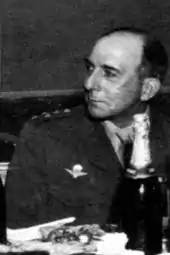| Battle of the Day River | |||||||||
|---|---|---|---|---|---|---|---|---|---|
| Part of the First Indochina War | |||||||||
 Jean de Lattre de Tassigny, commander of the French forces, who lost his only son in the battle. | |||||||||
| |||||||||
| Belligerents | |||||||||
|
| |||||||||
| Commanders and leaders | |||||||||
|
|
| ||||||||
| Strength | |||||||||
|
| Three divisions | ||||||||
| Casualties and losses | |||||||||
|
|
Western estimates: 9,000 killed[2][3][4] 1,000 captured[2] Việt Minh figures: 546 killed, 1,700 wounded, 280 missing[5] | ||||||||
The Battle of the Day River (French: bataille du Day) took place between late May and early June 1951, around the Day River Delta in the Gulf of Tonkin. Part of the First Indochina War, the battle was the first conventional campaign of Võ Nguyên Giáp, and saw his Việt Minh People's Army of Vietnam (VPA) forces tackle the Catholic-dominated region of the Delta in order to break its resistance to Việt Minh infiltration. On the back of two defeats at similar ventures through March and April that year, Giap led three divisions in a pattern of guerrilla and diversion attacks on Ninh Bình, Nam Định, Phủ Lý and Phat Diem beginning on May 28 which saw the destruction of commando François, a naval commando.
The French army, under Jean de Lattre de Tassigny, who lost his son in the first day of the battle at Ninh Bình, mobilised three mobile groups (groupements mobiles, similar to regimental combat teams) and two paratrooper battalions as well as one dinassaut,[6] and the ebb and flow of captured and retaken positions continued until Giap's supply lines were cut around June 6. His forces, moving in large numbers and during daylight, were vulnerable to French firepower and to French ground forces supported by a friendly local Catholic militia. The Việt Minh army units were forced into withdrawing between June 10 and June 18. The Western's sources estimated Việt Minh lost 1,000 prisoners to the French and 9,000 casualties.[7][8] Việt Minh reported they were suffered 546 killed, 1,700 wounded, 280 missing[9]
Notes
- ↑ Gras, p. 408
- 1 2 Logevall 2012, p. 272.
- ↑ Smith 2015, p. 74.
- ↑ Windrow 2011, p. 80.
- ↑ https://www.quansuvn.net/index.php/topic,24429.55/wap2.html
- ↑ Gras, Histoire de la Guerre d'Indochine, p. 407
- ↑ Windrow, p. 114-115.
- ↑ Fall, Street Without Joy, p. 45.
- ↑ https://www.quansuvn.net/index.php/topic,24429.55/wap2.html
References
- Smith, David (2015). Oxford IB Diploma Programme: Causes and Effects of 20th-Century Wars Course Companion. OUP Oxford.
- Fall, Bernard B. (1966). Hell in a Very Small Place. The Siege of Dien Bien Phu. London: Da Capo Press. ISBN 978-0-306-81157-9.
- Fall, Bernard B. (1961). Street Without Joy. The French Debacle in Indochina. New York: Stackpole Military History. ISBN 978-0-8117-3236-9.
- Fall, Bernard B. (1967). The Two Vietnams. A Political and Military Analysis (Second ed.). New York: Frederick A. Praeger, Inc.
- Gras, Yves (1979). Histoire de la Guerre d'Indochine. Paris. ISBN 2-259-00478-4.
{{cite book}}: CS1 maint: location missing publisher (link) - Logevall, Frederik (2012). Embers of war: the fall of an empire and the making of America's Vietnam. Random House. ISBN 9780375756474.
- Roy, Jules (1963). The Battle of Dien Bien Phu. New York: Carroll and Graf Publishers. ISBN 978-0-7867-0958-8.
- Windrow, Martin (2011). The Last Valley Dien Bien Phu and the French Defeat in Vietnam. Orion. ISBN 978-1-7802-2247-9.